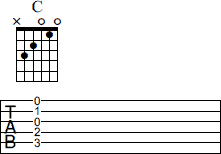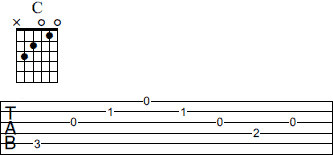How to read tabs (tablature)
 Tabs (tablature) is a system for music notation and is mostly associated with guitar. In comparison with standard notation, tabs are much easier and therefore more popular among guitarists, at least on beginner and intermediate levels.
Tabs (tablature) is a system for music notation and is mostly associated with guitar. In comparison with standard notation, tabs are much easier and therefore more popular among guitarists, at least on beginner and intermediate levels.
This guide will teach you all you need to read tabs and use it when you play guitar. The obvious purpose with tabs is to know how to play songs and melodies. Note that tabs aren’t the same thing as chords, although chords can be written out in tablature.
Tabs and chords
Since chords is such a central concept for the guitar, let´s start the guide by looking about chords and tabs. Chords are most often presented as a single chord name (C, Am, D7 etc.) or visualized in a diagram (or a chart). In a tab, chords are instead presented by numbers, by the notation can also be supported by a diagram above the tab system (see figure 1).

fig. 1 Chord in tablature with diagram
If we look at the tab and the numbers given, we can transfer them from the tablature into a six-figure formula: X32010. This six-figure formula represents from left to right the strings (from thickest to thinnest) of the guitar and indicate the fret position on the guitar neck. The “X” means that the strings shouldn’t be played.
Instead as a block chord, the tab can show a broken chord (see figure 2):

fig. 2 Broken chord in tablature with diagram.
Opposite to the previous example, the tones are played once at a time. Tabs are ideal for presenting fingerpicking patterns and the next example (see figure. 3) show this together with sound.

fig. 3 Fingerpicking pattern in tablature.
If we return, to the first example, we can expand with more chords and create a progression which spans over several bars. Bars (or measures) are divided by a vertical line and the following example include four bars (see figure 4). The next tab also includes symbols below the tab system, these are indications for down- and upstrokes with a pick. The first symbol tells us that the strum should be a downstroke, the second an upstroke and so on. The “>” signs indicate accents (strokes with emphases).
 fig. 4 Chords in tablature with down- and upstrokes.
fig. 4 Chords in tablature with down- and upstrokes.
Tab system – lines and numbers
You have probably realized by know that this music reading method is based on lines and numbers. The six horizontal lines represent the six strings on the instrument and the numbers represent the fret positions on the instrument.
To be clear, a “0” on the top line means that the highest (thinnest) string should be played open and a “1” on the second top line means that the second string should be played on the first fret.
That is primarily all you need to know to start using tabs in your guitar playing. You will, however, turn into more symbols which can be good to know the meaning of.
Which notes are represented by the numbers?
The following images gives examples of how the numbers in the tab system matches notes. Figure 5 shows notes for each open string.

fig. 5 Note letters for open strings in tablature
The next tab shows the note letters of C major scale starting from third fret, fifth string and involving several frets on the D- and G-strings as well.

fig. 6 Note letters for various positions in tablature
Leaning the fretboard of the guitar will make it easy to understand the relationship between notes and positions in tablatures.
Tab symbols
Aside from the numbers, various symbols may appear in tabs. These are often instructions for use of specific guitar techniques, such as bends, legato and vibrato.
Bends
Bends are marked with a curved arrow pointing up. Along with the arrow is the bend indicated with “full” (a whole step bend), “1/2” (a half step bend) or “1/4” (a mini bend).
You may also encounter two arrows together, with the first pointing and the second pointing down. This indicates a bend and release.
A third, not as common, variant is the prebend, often marked by an arrow pointed straight upwards. The pre-bend can be combined as either prebend and bend or prebend and release.
Vibrato
Vibratos are marked with wavy lines (or a “V” in simplified tablature), which means that the tones should be hold as a vibrato.
Less common is the tremolo bar vibrato, indicated with a zigzag line.
Slide
Slide is indicated with a diagonal line between the notes. So, ”7 / 9” means that a slide should start on the seventh fret and stop at the ninth fret.
In most cases, an arc is visible above the slide symbol should the tone before the diagonal line be played and when should we slide be done to the target not but without play this tone. This is called legato slide and is the most common way to use this technique. If no arc is visible, it is called a shift slide.
Sometimes is there any number before the diagonal line, as in “/ 9”. This is called slide in from below and means that the start position for the slide is optional but that it should target the ninth fret.
The opposite variant is “9 /”. This is called slide out downwards and means that the slide starts at the ninth fret but don’t have a specific end position.
Legato – hammer ons and pull offs
The two guitar techniques for legato are hammer on and pull off.
Hammer ons as well as pull offs are indicated with an arc between the notes. The way to know which of the techniques the notation refers to is decided from the fret positions. A hammer on is used when going from a low to a higher fret position and vice versa is true about pull offs.
Palm muting
Palm muting is marked with the abbreviation ”P.M.” above the tab system. The ”P.M.” are followed by dots that indicate how many bars that should be played palm muted.
More symbols and abbreviations
x – dead note (the string should be muted).
T – tap (normally accomplished with the right hand).
tr – trill.
() – parenthesis around a number indicates that the tone should be played very soft or not at all.
A.H. - artificial harmonics.
N.H. - natural harmonics.
P.H. - pinch harmonics.
w/bar - whammy bar.
w/dist - with dist (distortion effect should be used).
[dot] / [dot] – repeat the previous bar signs are indicated with a dot followed by a slash and when another dot.
Let ring – the tones should ring out.
Roman numerals – roman numerals above the tab system normally indicates barre and what fret.
p, i, m, a, c – these letters above the tab system indicates in Spanish which fingers to use for the right hand: pulgar (thumb), indice (index finger), medio (middle finger), anular (ring finger).
Numbers – numbers below the tab system indicates which fingers to use for the left hand: T for thumb, 1 for index finger, 2 for middle finger, 3 for ring finger, 4 for ring finger.
Alternative symbols sometimes used in tablatures
Other symbols not mentioned so far are listed below.
bs - bend
~ - vibrato
h - hammer on / pull off
s - slide
t - trill
L – legato arc
M - palm mute
+ - tapping
v – up stroke
^ - down stroke
V - up stroke with a pick
n - down stroke with a pick
See also chords in tab notation and chord and standard notation.